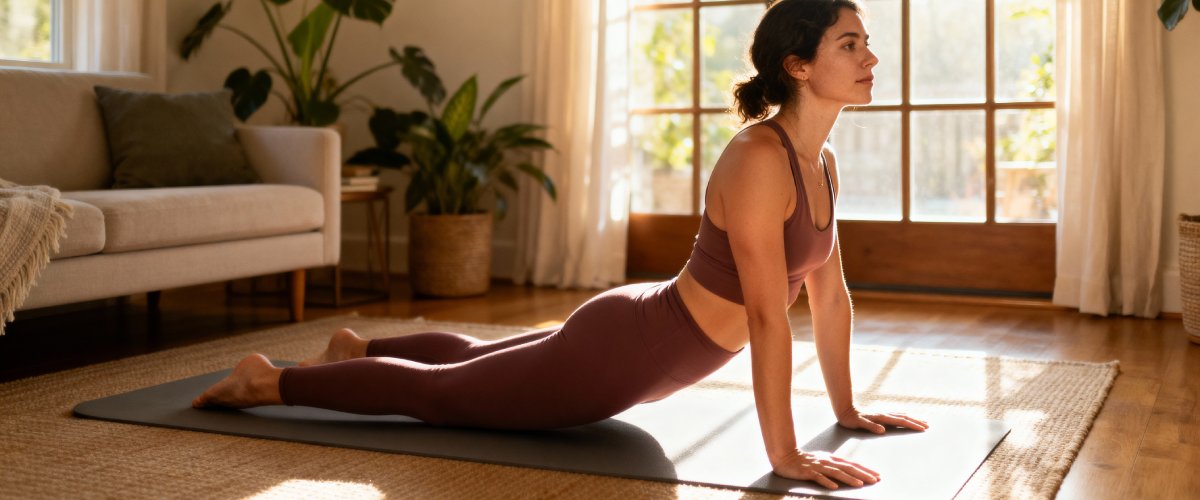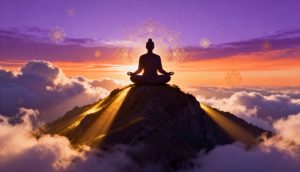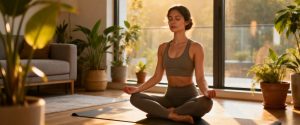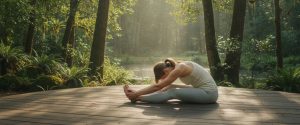Practicing yoga at home has become the favorite option for thousands of people. You don’t need to travel, you can adapt your schedule to your rhythm, and you create your own sacred space.
Yoga at home allows you to explore your practice without pressure. You can repeat poses, pause when you need to, and progress at your own pace. This freedom is especially valuable when you are starting out.
Many people find that regular practice at home perfectly complements in-person classes. Others prefer to start from home before taking the step to a yoga studio or school.
The best thing about yoga at home is its accessibility. You only need a small space, comfortable clothes, and the desire to start. The rest comes with consistent practice and dedication.
This guide will accompany you every step of the way. From your first postures to creating your own practice space. Let’s get to it.
How to start yoga at home for beginners
Yoga for beginners is easier than you think. You don’t need to be flexible or have prior experience. The only essential thing is your commitment to regular practice.
The basic equipment is minimal. A non-slip mat is your main investment. Then you can add yoga blocks and a blanket. But at the beginning, even a towel over a carpet can work perfectly.
Comfortable clothing is essential. Choose garments that allow you to move freely but are not too loose. You don’t need expensive athletic wear. Comfortable pants and a t-shirt are enough to get started.
The best time of the day depends on your routine. Many people prefer the early morning, on an empty stomach. Others find their ideal moment in the evening. Experiment and discover what works best for you.
Start with short sessions of 15-20 minutes. It’s better to practice for a short time but regularly than to have long sessions sporadically. Consistency is the key to progress in yoga.
Create a fixed schedule if possible. Practicing at the same time each day helps to build the habit. Your body and mind will start to naturally prepare for that practice time.
The right mindset makes all the difference. Yoga is not a competition. It’s not about achieving perfect poses from day one. It’s about connecting with your body and respecting its limits.
Always listen to your body. If a posture causes you pain, exit it. Yoga should create a sense of stretching but never sharp pain. Learn to distinguish between healthy discomfort and injury pain.
The breath is your best guide. If you can’t breathe deeply in a pose, you’re probably pushing too hard. Ease off a bit and find your comfort zone within each pose.
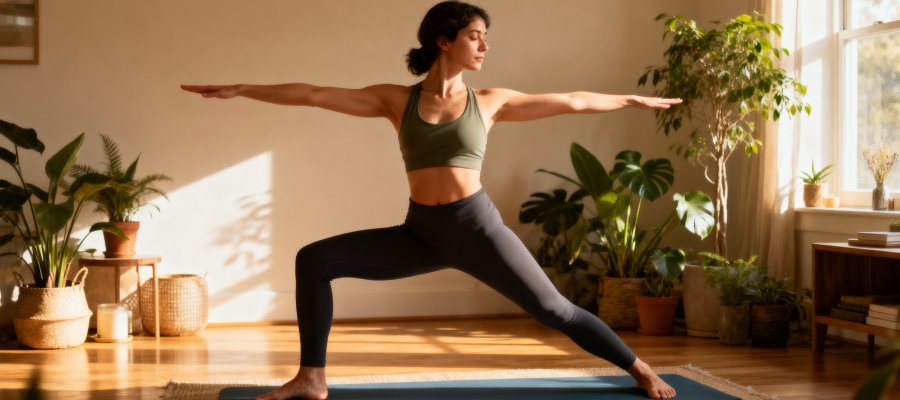
Basic yoga exercises and routines at home
Home yoga exercises are more accessible than you think. Here are the essential poses that will form the foundation of your practice. Master these first before exploring more complex variations.
Mountain Pose (Tadasana) is your starting point. It seems simple but teaches correct alignment and body awareness. It strengthens the legs and improves posture in your daily life.
Downward Dog (Adho Mukha Svanasana) stretches the entire posterior chain. It strengthens the arms and shoulders while lengthening the spine. It is one of the most recognizable and beneficial poses in yoga.
Warrior I (Virabhadrasana I) develops strength in legs and core. Opens the chest and improves balance. This pose helps you feel your personal power and stability.
Triangle (Trikonasana) deeply stretches the sides of the body. Strengthens legs and improves hip flexibility. Additionally, it works on balance in a gentle yet effective way.
Seated Forward Bend (Paschimottanasana) calms the mind while stretching the entire back. It is ideal for the end of practice. It helps relieve stress and improves digestion.
Child’s Pose (Balasana) is your refuge during practice. It allows you to rest and catch your breath when you need it. It gently stretches the lower back and relaxes the nervous system.
Savasana (corpse pose) concludes every yoga practice. It seems easy but requires conscious practice. It allows your body to integrate the benefits of the session.
A basic yoga session always follows a clear structure. First is the warm-up, then the development, and finally the relaxation. This progression prepares the body and prevents injuries.
The warm-up lasts approximately 5 minutes. It includes gentle joint movements and conscious breathing. It can simply be neck stretches, shoulder rolls, and spinal movements.
The development is the core of your practice. Here you work on the main postures for 10-15 minutes. Alternate standing poses, balance, and floor poses for a balanced practice.
The final relaxation is as important as the rest. Spend at least 5 minutes in Savasana. This moment allows your nervous system to integrate all the benefits of the exercise.
Your ideal weekly routine includes 3-4 sessions. Leave a rest day between practices when you start. As you progress, you can gradually increase the frequency.
Monday, Wednesday, and Friday work well for many people. On weekends, you can do longer sessions if you wish. Adjust according to your energy and actual availability.
Vary the postures you practice each day. One day focus on standing and strength postures. Another day prioritize stretches and flexibility. This variation keeps your practice interesting and balanced.
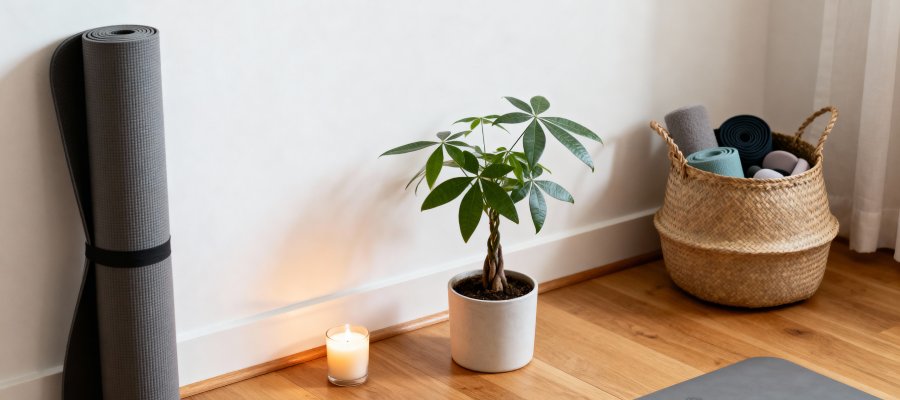
Creating Your Yoga Space at Home
Your home yoga space doesn’t need to be a full room. A quiet corner of 2×2 meters is enough to develop a complete practice. What’s important is that it is your dedicated space.
Look for a place with level flooring where you can fully spread out your mat. You need to be able to stretch your arms in all directions without hitting furniture. Safety is essential for practicing with confidence.
The natural light is ideal but not essential. If your space has a window, take advantage of it for morning practices. For evening sessions, a warm and dimmable light creates the perfect atmosphere.
The ventilation is more important than you think. Yoga generates body heat and you need fresh air circulating. A window that you can open or a quiet fan are good options.
Creating a yoga corner in the living room works perfectly for many people. Choose a space that you can keep relatively clear. Even if you store the mat afterward, that corner will be your practice area.
The yoga decor at home should be minimalistic and personal. You don’t need to transform your home into an ashram. Simple details can make a difference in your daily motivation.
A natural plant adds life and purifies the air. Choose resilient species like a pothos or a sansevieria. Green brings calm and connects with nature even in urban spaces.
A candle or incense can mark the beginning of your practice. This small ritual helps your mind switch modes. Choose gentle scents like lavender, sandalwood, or simply unscented.
A singing bowl or small bell is optional but beautiful. Using it to begin and end creates a ritual frame. The sound helps focus attention and conclude the practice.
Keep your space neat and clean. A cluttered space scatters the mind. Store your accessories in a pretty basket or specific corner after practicing.
The ambient music can accompany your practice if it helps you. Choose natural sounds, soft instrumental music, or traditional mantras. Some people prefer absolute silence. Both options are valid.
If you have an extra room you can create your dedicated yoga space. Paint the walls in neutral and warm tones. Keep the space free of distractions like television or computer.
Resources for practicing yoga at home
Finding free yoga classes at home is easier than ever. The internet offers thousands of options but the abundance can be overwhelming. The important thing is to find resources that suit your level and style.
YouTube is full of channels specialized in yoga for beginners. You can find everything from 10-minute sessions to full hour classes. The advantage is that you can try different instructors and styles.
Mobile applications offer structured programs that track your progress. Many have free options with quality content. Some even allow you to download classes to practice offline.
Free videos are perfect for starting and exploring. They give you the freedom to practice whenever you want without commitments. However, the lack of structure may cause you to lose your way.
The self-guided classes depend entirely on your discipline. They require prior knowledge of the poses and their names. They are ideal when you already have experience and want total freedom.
The structured courses offer a logical and planned progression. They guide you step by step from the basics to more advanced levels. This structure eliminates any doubts about what to practice each day.
The professional guidance makes a significant difference in your progress. A qualified instructor corrects your alignment and prevents injuries. It helps you delve into aspects you would not discover on your own.
Combining free resources with professional training is the ideal approach. Free resources allow you to explore and practice regularly. Professional courses provide you with solid foundations and correct technique.
Our school offers online yoga courses specifically designed for practicing at home. Progressive programs that respect your pace with access to experienced instructors. From beginner levels to advanced specializations.
The courses include personalized posture correction through videos. A community of students to share experiences and motivation. Supplementary material on philosophy, breathing, and meditation that enriches your practice.
Investing in your yoga training is investing in your long-term well-being. A good course saves you years of incorrect practice. It gives you confidence and knowledge to evolve safely.
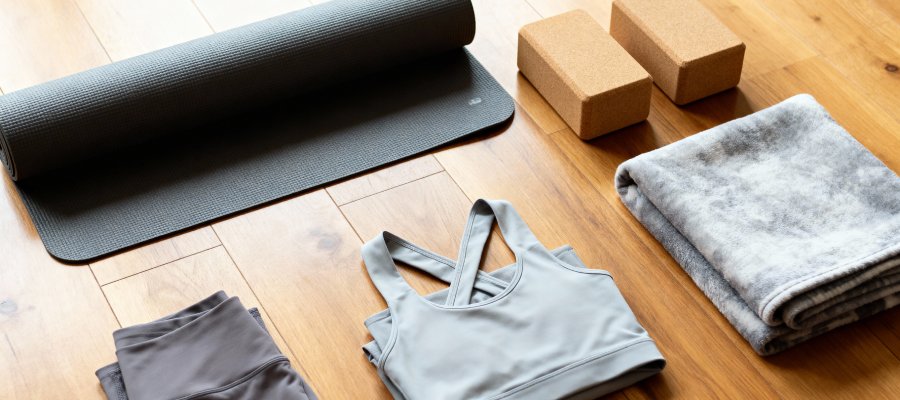
Tips and common mistakes to avoid
The most common mistake is skipping the warm-up in a hurry. Jumping straight into complex poses increases the risk of injury. Always spend those initial 5 minutes preparing your body.
Comparing yourself to others is a common mental trap. Every body is different and has its own pace of progress. Your only competition is with yourself and your practice from yesterday.
Forgetting your breath while focusing on the posture is quite common. Breath is the heart of yoga, not a secondary detail. If you lose your conscious breath, adjust the intensity of the posture.
Many beginners overexert themselves in search of quick results. Yoga is not a race but a lifelong journey. Real progress comes from consistent and patient practice.
Practicing on a full stomach causes discomfort and limits movement. Wait at least 2 hours after a main meal. You can have a light snack 30 minutes before if needed.
Ignoring pain by thinking it is normal in yoga is dangerous. Differentiate between healthy stretching and injury pain. Sharp or stabbing pain is a clear signal to stop.
The correct breathing in yoga is nasal, deep, and controlled. Inhale and exhale always through the nose unless specifically instructed otherwise. Mouth breathing activates the sympathetic nervous system and creates tension.
Holding your breath while sustaining a pose is counterproductive. If you can’t breathe comfortably, you are pushing too hard. Smooth breathing indicates you are within your healthy limit.
Practicing inconsistently significantly slows your progress. Three short sessions a week are more effective than one long occasional session. Consistency builds habit and results.
Knowing when to seek professional help is a sign of maturity in your practice. If you have prior injuries, medical conditions, or persistent doubts, seek guidance. A qualified instructor can tailor the practice to your specific needs.
Your yoga practice starts here
Now you have everything you need to begin your home yoga practice. You know the basic poses, you understand how to structure a session, and you are clear about what mistakes to avoid.
Yoga does not require perfection from day one. It requires presence, conscious breathing, and respect for your body. These three pillars will always accompany you, regardless of your level.
Your first step is simply to unroll the mat. Don’t think about the perfect session or mastering complex poses. Spend 15 minutes being present with your body and your breath.
The transformation of yoga occurs in daily repetition. Not in exceptional sessions, but in constant and humble practice. Every day you show up on your mat, you are making progress.
If you seek professional guidance to deepen your practice, our school supports you on the journey. Courses designed to evolve from home with the guidance of experienced instructors.
We offer programs from beginner to advanced level. Each course includes personalized feedback, a supportive community, and ongoing access to materials. Your investment in yoga is your investment in well-being.
Discover our courses and take the next step in your practice. We are here to support you with knowledge, experience, and passion for yoga.
Your mat is waiting for you. Your practice starts today.
